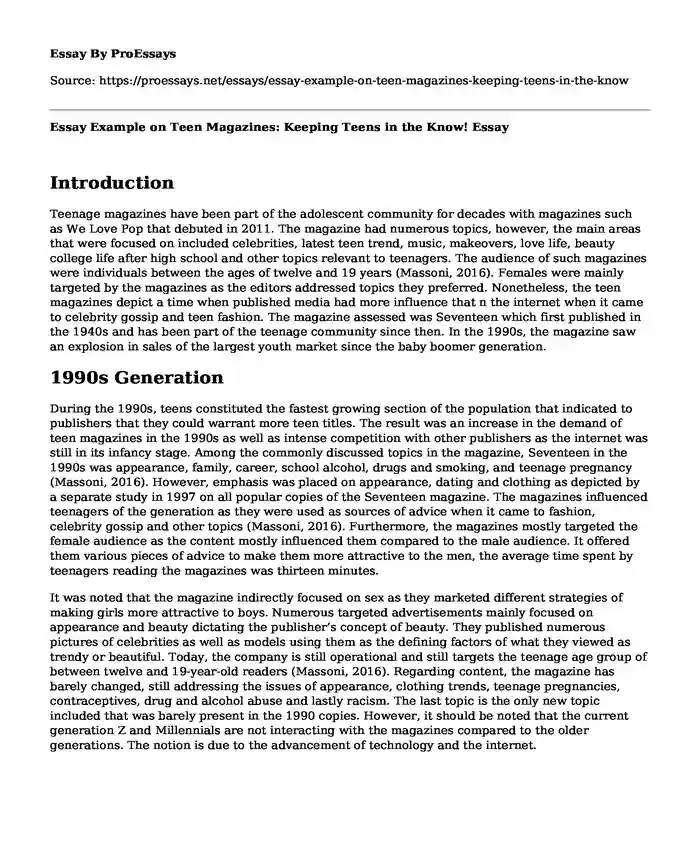Introduction
Teenage magazines have been part of the adolescent community for decades with magazines such as We Love Pop that debuted in 2011. The magazine had numerous topics, however, the main areas that were focused on included celebrities, latest teen trend, music, makeovers, love life, beauty college life after high school and other topics relevant to teenagers. The audience of such magazines were individuals between the ages of twelve and 19 years (Massoni, 2016). Females were mainly targeted by the magazines as the editors addressed topics they preferred. Nonetheless, the teen magazines depict a time when published media had more influence that n the internet when it came to celebrity gossip and teen fashion. The magazine assessed was Seventeen which first published in the 1940s and has been part of the teenage community since then. In the 1990s, the magazine saw an explosion in sales of the largest youth market since the baby boomer generation.
1990s Generation
During the 1990s, teens constituted the fastest growing section of the population that indicated to publishers that they could warrant more teen titles. The result was an increase in the demand of teen magazines in the 1990s as well as intense competition with other publishers as the internet was still in its infancy stage. Among the commonly discussed topics in the magazine, Seventeen in the 1990s was appearance, family, career, school alcohol, drugs and smoking, and teenage pregnancy (Massoni, 2016). However, emphasis was placed on appearance, dating and clothing as depicted by a separate study in 1997 on all popular copies of the Seventeen magazine. The magazines influenced teenagers of the generation as they were used as sources of advice when it came to fashion, celebrity gossip and other topics (Massoni, 2016). Furthermore, the magazines mostly targeted the female audience as the content mostly influenced them compared to the male audience. It offered them various pieces of advice to make them more attractive to the men, the average time spent by teenagers reading the magazines was thirteen minutes.
It was noted that the magazine indirectly focused on sex as they marketed different strategies of making girls more attractive to boys. Numerous targeted advertisements mainly focused on appearance and beauty dictating the publisher’s concept of beauty. They published numerous pictures of celebrities as well as models using them as the defining factors of what they viewed as trendy or beautiful. Today, the company is still operational and still targets the teenage age group of between twelve and 19-year-old readers (Massoni, 2016). Regarding content, the magazine has barely changed, still addressing the issues of appearance, clothing trends, teenage pregnancies, contraceptives, drug and alcohol abuse and lastly racism. The last topic is the only new topic included that was barely present in the 1990 copies. However, it should be noted that the current generation Z and Millennials are not interacting with the magazines compared to the older generations. The notion is due to the advancement of technology and the internet.
2010s Generation
Data from the Association of Magazine Media identify that print media sales have been dropping from the early 2010s (Jenkins, 2020). Teenagers are more interested in digital media resulting in the Seventeen Magazine, reducing its publishing volume and increasing its online content. Regardless, as earlier stated, the only new topic that has been included in the magazine is the social issue of racism. It must be appreciated that racism has been part of American culture for decades, and it was at its peak in the 1990s with numerous unwarranted violence against the minorities. With the massive movements today demanding institutional change over the racism, the platform has also been active. Additionally, the content of the 1990s mainly consisted of white men and women (Massoni, 2016). Focusing skinny models, with digitally altered flawless skin, wearing the trending clothes, cosmetic makeup and hairstyles.
Though the magazine initially promoted the notion of skinny teenagers, and specific fashion and cosmetic trends in the 1990s, today, it has become more responsible (Massoni, 2016). It has changed its perspective and how it addresses its audience. Currently, the magazine addresses most female body types offering numerous advice relating to fashion and cosmetics. Additionally, they are promoting healthy diets that are beneficial to the audience compared to its previous publications.
Conclusion
Overall, it is evident that the teenage magazines have evolved from the 1990s to date. Publishers have addressed major topics relating to the image with the majority of them changing to support a more responsible generation. It is achieved by avoiding topics that promote underage sex, the use of drugs and image, among others. However, topics such as dating remain prevalent with the topic becoming more noticeable among the male group. It is during the preteen phase that both sexes become interested in the notion of courtship and the magazine offers the necessary advice. Though some of the topics have changed over time, some remain the same as demonstrated.
References
Jenkins, J. (2020). Magazines' Construction of Life Markers. The Handbook Of Magazine Studies, 226-240. https://doi: 10.1002/9781119168102.ch17
Massoni, K. (2016). Fashioning teenagers. Routledge.
Cite this page
Essay Example on Teen Magazines: Keeping Teens in the Know!. (2023, Sep 26). Retrieved from https://proessays.net/essays/essay-example-on-teen-magazines-keeping-teens-in-the-know
If you are the original author of this essay and no longer wish to have it published on the ProEssays website, please click below to request its removal:
- Speech Rhetorical Devices Essay
- Cricket as a Conflict Resolution Ritual in PNG Paper Example
- Turkle's and Pelton's Discussion on Impact of Technology's on Future Generations
- Paper Example on Multiple Intelligence: Understanding Human Capabilities
- Essay on Hip Hop Music: Uncovering Root Causes of Racial Inequality and Proposing Solutions
- Movie Analysis Essay on Black Panther
- Performance Art: Creating Meaning Through Action - Essay Sample







